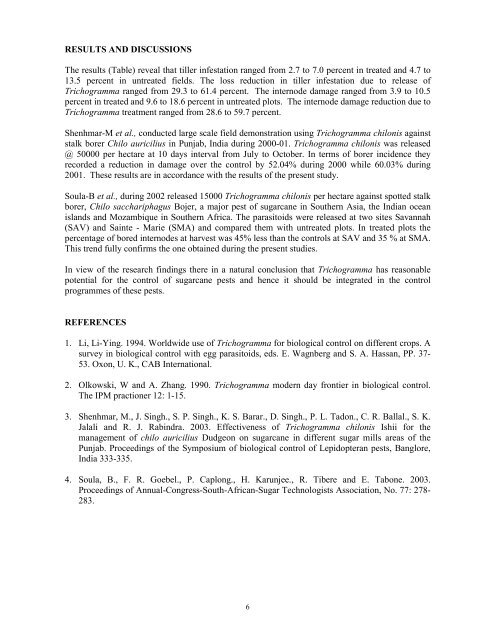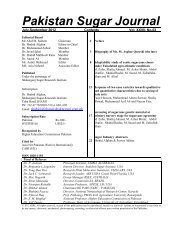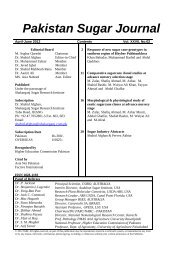Sep to Oct 2006 - Shakarganj
Sep to Oct 2006 - Shakarganj
Sep to Oct 2006 - Shakarganj
You also want an ePaper? Increase the reach of your titles
YUMPU automatically turns print PDFs into web optimized ePapers that Google loves.
RESULTS AND DISCUSSIONS<br />
The results (Table) reveal that tiller infestation ranged from 2.7 <strong>to</strong> 7.0 percent in treated and 4.7 <strong>to</strong><br />
13.5 percent in untreated fields. The loss reduction in tiller infestation due <strong>to</strong> release of<br />
Trichogramma ranged from 29.3 <strong>to</strong> 61.4 percent. The internode damage ranged from 3.9 <strong>to</strong> 10.5<br />
percent in treated and 9.6 <strong>to</strong> 18.6 percent in untreated plots. The internode damage reduction due <strong>to</strong><br />
Trichogramma treatment ranged from 28.6 <strong>to</strong> 59.7 percent.<br />
Shenhmar-M et al., conducted large scale field demonstration using Trichogramma chilonis against<br />
stalk borer Chilo auricilius in Punjab, India during 2000-01. Trichogramma chilonis was released<br />
@ 50000 per hectare at 10 days interval from July <strong>to</strong> Oc<strong>to</strong>ber. In terms of borer incidence they<br />
recorded a reduction in damage over the control by 52.04% during 2000 while 60.03% during<br />
2001. These results are in accordance with the results of the present study.<br />
Soula-B et al., during 2002 released 15000 Trichogramma chilonis per hectare against spotted stalk<br />
borer, Chilo sacchariphagus Bojer, a major pest of sugarcane in Southern Asia, the Indian ocean<br />
islands and Mozambique in Southern Africa. The parasi<strong>to</strong>ids were released at two sites Savannah<br />
(SAV) and Sainte - Marie (SMA) and compared them with untreated plots. In treated plots the<br />
percentage of bored internodes at harvest was 45% less than the controls at SAV and 35 % at SMA.<br />
This trend fully confirms the one obtained during the present studies.<br />
In view of the research findings there in a natural conclusion that Trichogramma has reasonable<br />
potential for the control of sugarcane pests and hence it should be integrated in the control<br />
programmes of these pests.<br />
REFERENCES<br />
1. Li, Li-Ying. 1994. Worldwide use of Trichogramma for biological control on different crops. A<br />
survey in biological control with egg parasi<strong>to</strong>ids, eds. E. Wagnberg and S. A. Hassan, PP. 37-<br />
53. Oxon, U. K., CAB International.<br />
2. Olkowski, W and A. Zhang. 1990. Trichogramma modern day frontier in biological control.<br />
The IPM practioner 12: 1-15.<br />
3. Shenhmar, M., J. Singh., S. P. Singh., K. S. Barar., D. Singh., P. L. Tadon., C. R. Ballal., S. K.<br />
Jalali and R. J. Rabindra. 2003. Effectiveness of Trichogramma chilonis Ishii for the<br />
management of chilo auricilius Dudgeon on sugarcane in different sugar mills areas of the<br />
Punjab. Proceedings of the Symposium of biological control of Lepidopteran pests, Banglore,<br />
India 333-335.<br />
4. Soula, B., F. R. Goebel., P. Caplong., H. Karunjee., R. Tibere and E. Tabone. 2003.<br />
Proceedings of Annual-Congress-South-African-Sugar Technologists Association, No. 77: 278-<br />
283.<br />
6






